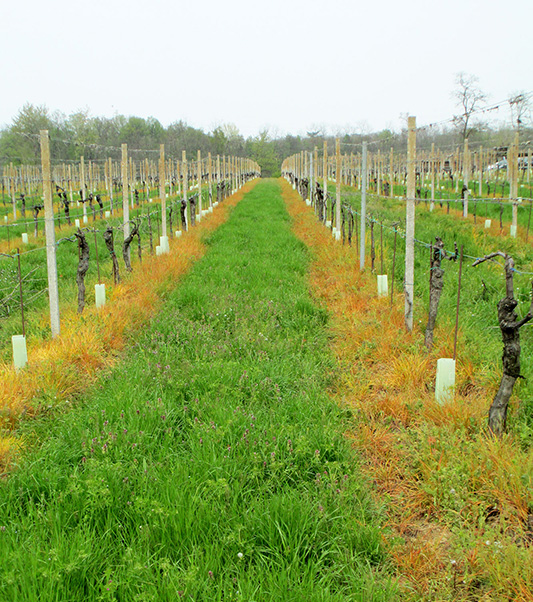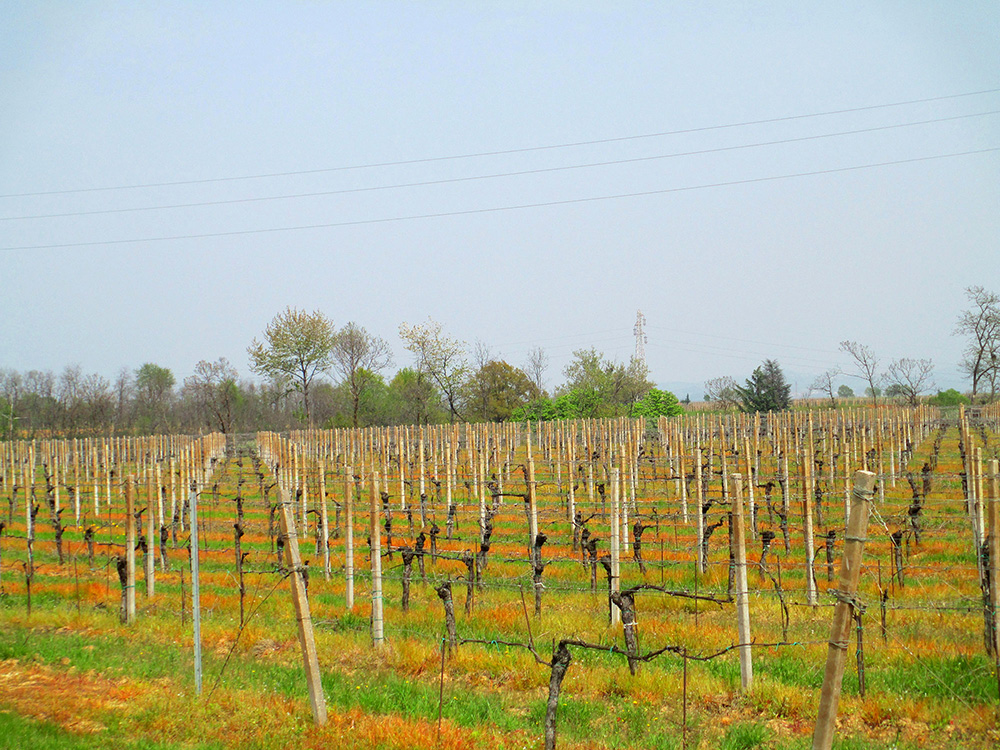"Chemical" (or conventional)vineyards
Consumers often are not informed about how “chemical” (or so-called conventional) vineyards are cultivated, and thus remain oblivious to the production process of any wine which does not have an organic or biodynamic certification on its label. In fact, it is hard to understand for anyone who does not work in a “chemical” vineyard (99% of all vineyards in the world are of that type).
From April to the harvest period in September, tractors and helicopters spray the vineyards with systemic pesticides sold by big pharmaceutical companies. Systemic pesticides are not washed away by the rain, but penetrate into the plants and make their way to the grapes.
It all begins in spring, a season in which nature is marvellous and full of buds, after a long winter break, with the application of desiccant to the area around the stumps of the vine. As its name suggests, desiccant causes the organisms it come into contact with to dry out, without being transferred. For this reason, it is also used in the chemical suckering of grapevine or hazelnut trees.
Viticulturists who really cannot stand the grass also spray it around the vineyards for tens of meters, unaware that it pollutes and poisons the groundwater:
in fact, it is highly unlikely not to find traces of it. In spring you can often see patches of dried grass at the sides of asphalted roads, in gardens, around the water of rice fields, and so on: this is a sign that those areas have been treated, or got into contact with desiccant – because grass in spring is usually bright green.
Walking around the vineyards in spring, you will likely notice mysterious stripes of yellowish grass on the ground between the vine rows. Those are the marks of the first treatment with desiccant, and you can only hope that the prescribed doses have been respected (because some farmers do not even read the labels) and that it has been applied by workers wearing protective clothes and a mask, because it is very dangerous for the plants, the animals and us humans. The treatment is often repeated when the plants have grown to a certain height.
Systemic pesticides are not washed away by the rain, but penetrate into the plants and make their way to the grapes.
In May, when the first leaves appear on the vines, treatments with more aggressive synthetic chemicals begin, which are always systemic. There are many different types of such chemicals, and they are all toxic for people, animals and the earth. Some are so toxic that they cannot be used without a special licence (unfortunately not many vineyard owners have it, and there is no such thing as a vineyard police). These products are used all the way from flowering to fruit formation and fruit development.
Pharmaceutical companies warn farmers to avoid working in direct contact with the plants during treatment periods, but all workers do so, with their bare hands and without using masks. At the beginning of August vineyard owners interrupt the systematic poisoning of the plants against vine diseases, only to go over to the next poison: anti-mould products. The latter keep the grapes from developing mould before being harvested. It can only be applied up to one month prior to the harvest. But who is going to respect that rule?
In the must, and then in the wine, there are all the residues of the past months’ treatments and anti-mould products, which remain on the skins of the grapes and inside the fruits that are going to be pressed – without being washed first. In fact, it is recommended not to eat the grapes before or during the harvest, and in some cases it can even be dangerous.


Once the harvest is complete, workers begin to generously spray on yet another “chemical”, which easily spreads in the soil: chemical fertilizer. Besides boosting the vines, it stimulates the growth of the grass which will then be eliminated with the desiccant in spring. And thus, the circle of the grapevine is closed, a circle which every year poisons the earth, the air, the water, the environment, animals and human beings. Bees, which play an important role in the reproduction of flowers and therefore also of fruit and vegetables, are one of the most endangered species. In the summer of 2008, here in Gavi, a helicopter sprayed on very toxic pesticides that could only have been applied with a tractor and a special licence. A lot of bees of a friend of ours, a great believer in organic apiculture, died as a consequence.
In summary, conventional agriculture disturbs the balance of the plants, in contrast to biodynamic agriculture, which supports that balance. It uses great amounts of fertilizer, which causes the grass to grow faster – and then desiccant. It results in the overproduction of grapes, which is why sometimes viticulturists resort to the practice of “green harvesting”, that is the thinning of clusters in July/August in vineyards where too many grapes develop, in order to improve their quality.
In conventional vineyards the natural balance of the plants is disrupted, which triggers a cycle of disequilibria for which man has to constantly make amends: a bit like the act of giving birth, which, when it starts with a medical intervention, most of the times it ends with a surgery.